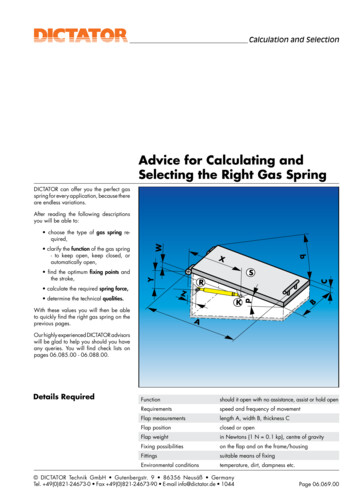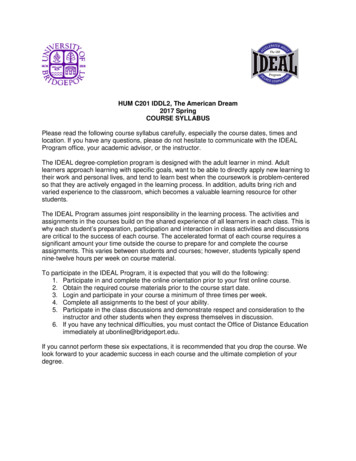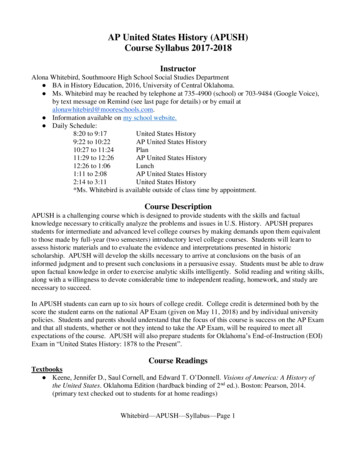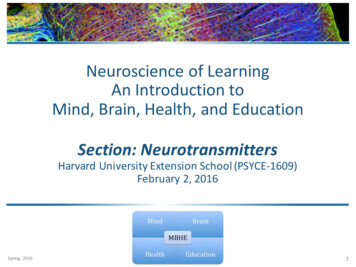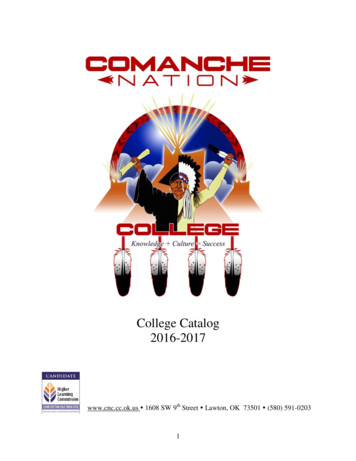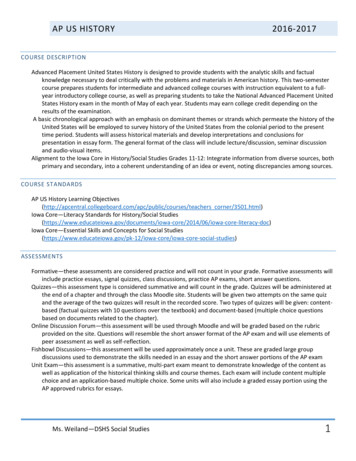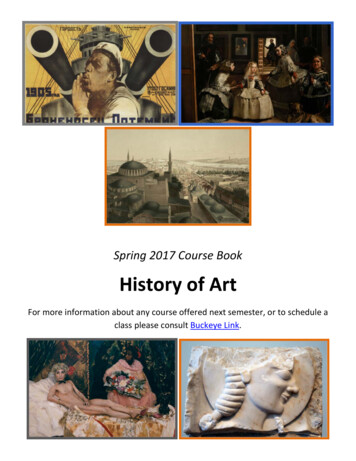
Transcription
Spring 2017 Course BookHistory of ArtFor more information about any course offered next semester, or to schedule aclass please consult Buckeye Link.
Courses by InstructorFlorman, LisaHistory of Art 8000Cartelami, Cardboard Constructions,& Material CultureGluibizzi, AmandaHistory of Art 4640Media/Spectacle: Art since 1945Hamann, ByronHistory of Art 4010An Introduction to the Methods andTheories of Art HistoryHistory of Art 5002Blood, Flesh, Spirit:The Body in Mesoamerican ArtKleinbub, ChristianHistory of Art 2002History of Western Art II:The Renaissance to the PresentKunimoto, NamikoHistory of Art 3605 (Honors)Photography East and WestHistory of Art 4016Senior Research Seminar: Gender inEast Asian ArtLevin, EricaHistory of Art 3901World Cinema TodayMathison, ChristinaHistory of Art 2003East Asian ArtHistory of Art 4810The Arts of ChinaHistory of Art 4001Writing SeminarHistory of Art 5621Post-Impressionism to DadaNeumeier, EmilyHistory of Art 4020Special Topics: Imperial CitiesPaulsen, KrisHistory of Art 2901Introduction to World CinemaHistory of Art 5643New Media & Art TheoryHistory of Art 3611Impressionism, Then and NowHistory of Art 8601Studies in Modern Art:Towards an Alternative History of19th-Century European PaintingMarcus, DannyShelton, Andy
Whittington, KarlHistory of Art 5422Medieval ManuscriptIlluminationHistory of Art 8001Queer Art History
History of Art 2001History of Western Art I: The Ancient and MedievalWorldsCall#18950Mondays & Wednesdays 9:10-10:05Recitation: Thursdays or Fridays 9:10-10:05This course examines the history of Western Art (architecture, painting, and sculpture) from the third millennium BCE tothe 14th century CE. Rather than a complete survey of that period, the course will concentrate on a select group ofrepresentative buildings, objects and images. We will examine not only the works themselves, but also the historicalcontext in which they were produced. The goal is to impart not only a body of knowledge but also a set of critical tools,which you should be able to apply even to artworks and buildings not specifically covered in this course. Historical periodscovered include the Ancient Near East and Egypt, Classical Greece and Rome, and the European Middle Ages. Topicsaddressed include the historical functions of works of art, representations of power and authority, religious buildings andimages, representations of gender and the body, and the constantly evolving history of artistic styles.Fulfills these GE requirements: Diversity (Global) Studies; Historical Studies; VPA.History of Art 2001 NightHistory of Western Art I: TheAncient and Medieval WorldsCall#18959Tuesdays & Thursdays 5:30-6:50pThis course examines the history of Western Art (architecture, painting and sculpture) from the third millennium BCE throughthe fifteenth century CE. Rather than a complete “survey” of that period, the course will concentrate its attention on a selectgroup of representative monuments. We will examine not only the monuments themselves, but also the historical context inwhich they were produced in order to explore their purpose and the way that they functioned. There will be a strong emphasison visual analysis and understanding how visual forms convey meaning and relate to the viewer. Our goal is to impart not onlya body of knowledge but also a set of critical tools, which you should be able to apply to even material not specifically coveredin this course.Fulfills these GE requirements: Diversity (Global) Studies; Historical Studies; VPA.
History of Art 2002History of Western Art II:The Renaissance to the PresentProfessor Christian KleinbubKleinbub.1@osu.eduCall #18960Mondays & Wednesdays 10:20-11:15Recitation: Thursdays or Fridays 10:20-11:15This course examines the art of the United States and Europe from about 1500 to the present, with an emphasis onpainting. It will concentrate on a select group of representative works that shaped—and were shaped by— developmentsin western social, political, and intellectual history and that participated in individual and community identity formation.There will be a strong emphasis on questions of analysis and interpretation, as the goal is to impart not only a body ofknowledge but also a set of critical tools that you should be able to apply to a wide range of material not specificallycovered in the course.Fulfills these GE requirements: Diversity (Global) Studies;Historical Studies; VPA.History of Art 2002 NightHistory of Western Art II:Renaissance to PresentCall #18969Tuesdays & Thursdays 5:30-6:50This course examines the art of the United States and Europe from about 1500 to the present, with an emphasis onpainting. It will concentrate on a select group of representative works that shaped—and were shaped by— developmentsin western social, political, and intellectual history and that participated in individual and community identity formation.There will be a strong emphasis on questions of analysis and interpretation, as the goal is to impart not only a body ofknowledge but also a set of critical tools that you should be able to apply to a wide range of material not specificallycovered in the course.Fulfills these GE requirements: Diversity (Global) Studies; Historical Studies; VPA.
History of Art 2003East Asian ArtChristina Burke MathisonMathison.5@osu.eduCall #18970Mondays & Wednesdays 11:30-12:25Recitation: Thursdays or Fridays 11:30-12:25This course offers an introduction to the visual arts in East Asia, from the Neolithic through today. The course examines inparticular the relationship between cultural production and changing notions of authority in East Asia in a comparativehistorical perspective. Case studies will be drawn from China, Japan, and neighboring regions. Issues examined include:religion and early state formation; courtly culture and monumentality; the development of urban popular culture; the ageof empire; art and modernization.Fulfills these GE requirements: Diversity (Global) and either Historical Studies or Arts & Humanities VPA.History of Art 2901Introduction to World CinemaProfessor Kris PaulsenPaulsen.20@osu.eduCall #18973Tuesdays & Thursdays 9:35-10:55This course will introduce students to the history of film as an artistic medium and a global art form. We will tracktechnological, aesthetic, and formal developments in its evolution from photographic and proto-cinematic technologiesto digital cinema by studying particular masterpieces, and focusing on the role of the director or auteur. We will pay closeattention to the medium’s complex relationship to time, its changing materiality (and “medium specificity”), and itsfraught relationship to truth and reality. Students will engage in a historical and formal study of international cinemathrough a chronological survey of its major forms, techniques, and its relationship to the broader history of art, as well associal and political history. We will sample its major and “minor” forms, from Hollywood productions to art galleryexperiments and cinema from the developing world. Students will be introduced to the grammar of film through ahistorical account of its formal evolution and the stylistic analysis of the visual and narrative structures of individual films.Fulfills these GE requirements: Diversity (Global) Studies; VPA.
History of Art 2901 NightIntroduction to World CinemaCall #18974Mondays & Wednesdays 5:30-6:50This course will introduce students to the principal films, directors, and movements of World Cinema from the beginningof the twentieth century to the present day. Emphasis will be on helping students acquire and develop the requisite skillsfor analyzing the formal and stylistic aspects of specific films, and on helping students understand those films in their socialand historical contexts.Fulfills these GE requirements: Diversity (Global) Studies; VPAHistory of Art 3605HPhotography East and West(Honors)Professor Namiko KunimotoKunimoto.3@osu.eduCall #TBDWednesdays & Fridays 2:20-3:40This course will begin with the emergence of photography and will examine the medium’s pivotal role in shaping relationsbetween Asia and the West. We will explore early portraiture, architectural sites, colonial tourism, popular culture, familyphotographs, and contemporary art photography. No previous experience in Asian art or photography required.Fulfills these GE requirements: VPA.
History of Art 3611Impressionism, Then and NowProfessor Andrew SheltonShelton.85@osu.eduCall #32843Tuesdays & Thursdays 3:55-5:15This course offers a historical and critical exploration of one of the most beloved movements in the entire history of Western art:French Impressionism. In addition to considering the major artists of this movement and the social, political, and cultural contexts inwhich they lived and worked, this course will also critically examine the enduring fascination with Impressionism throughout the pasthundred years. Among the questions we will ask: Is the current popularity of Impressionism based on a misunderstanding of the radicalnature of what was originally a profoundly revolutionary style, or, alternatively, is its current stature based on the legitimateappreciation of what was and remains a quintessentially “easy,” escapist, “viewer-friendly” form of artistic expression? How is it thatthe precedent of French Impressionism continues to inform popular notions about art today? To what extent has the generalpopularity of Impressionism produced a backlash among academics and connoisseurs?Although centered on a precise historical period, this course is designed specifically to give non-specialists a basic grounding in theunderstanding and analysis of works of visual art; an introduction to the fundamental methods and techniques of art historical analysis;and a critical appreciation of the impact and basic operations of visual culture in contemporary society.Fulfills these GE requirements: VPA.History of Art 3901World Cinema TodayProfessor Erica LevinLevin.1996@osu.eduCall #18975Tuesdays & Thursdays 2:20pm-3:40pmDespite its common usage “world cinema” lacks a proper, positive definition. It tends to be defined negatively as “non-Hollywoodcinema,” which Lúcia Nagib observes, “unwittingly sanctions the American way of looking at the world, according to which Hollywoodis the center and all other cinemas are the periphery.” This course provides an introduction to world cinema that attends carefully toquestions of definition. The emergence of global art cinema is often mapped as a succession of “new waves”: Italian neorealism, theFrench nouvelle vague, the Danish Dogma movement and New Iranian Cinema. We will look at how the aesthetics of realism,concerned above all with the texture and temporality of everyday life, set these film movements (and other parallel developments inAfrican, Latin American, Asian cinema) apart from films shaped by the codes of genre and commercialism. We will consider how recentworld cinema departs from realism to depict experiences characterized by transnationalism, post-colonialism, and migration. Placingthese films into the broader historical and (multi-) cultural contexts of their production, we will examine how world cinema today notonly engages life in the present, but also calls up occluded fragments of the past.Fulfills these GE requirements: VPA.
History of Art 3901 NightWorld Cinema Today (Night)Call #18977Tuesdays & Thursdays 5:30-6:50In 1930, film theorist Béla Balázs remarked that it was impossible to speak of “the people of the world,” but if that daywere ever to arrive, film would be there “ready and waiting to provide the universal spirit with its corresponding techniqueof expression.” Today technology has altered the world, making it feel both smaller and infinitely expanded at the sametime. Does film still hold the promise of universal expression under these conditions? If not, what does it promise now?What do film’s “techniques of expression” correspond to in our contemporary world? In this course, we will look carefullyat cinematic form and the socio-political conditions that shape film production across the globe today. At the same timewe will also examine the ideas and fantasies that animate “world cinema” as a label for certain kinds of films. Why dosome critics and theorists embrace this term while others find it inadequate, something in need of qualification orreplacement? What corrections and critiques have these writers offered? How do their observations challengeassumptions about the way film makes the world available to each of us as viewers?Fulfills these GE requirements: VPA.History of Art 4001Writing SeminarDanny MarcusMarcus.140@osu.eduCall #33482Wednesdays & Fridays 9:35-10:55This course serves as a third-level writing course and is intended for History of Art majors. Conducted as a seminar, thecourse will introduce students to the practice of writing in the discipline of art history. In order to hone our analytic andinterpretive skills, we will undertake a series of sustained and critical engagements with specific works of art and key arthistorical texts, focusing on the practice of written description and visual analysis. Through class discussions, oralpresentations, and written exercises and assignments, students will develop the ability to write compellingly about worksof art, while becoming better acclimatized to the discourses and protocols of art-historical argumentation.
History of Art 4010An Introduction to the Methods andTheories of Art HistoryProfessor Byron HamannHamann.40@osu.eduCall #18976Tuesdays & Thursdays 11:10-12:30This course provides an overview of the history of art history, paying particularly close attention to the writings of majorfigures who have contributed to the methodological and theoretical development of the discipline. The course, which isreading intensive, is required of all history of art majors, and is open to other interested students with the permission ofthe instructor.History of Art 4016Senior Research Seminar:Gender in East Asian ArtProfessor Namiko KunimotoKunimoto.3@osu.eduCall #26487Wednesdays & Fridays 11:10-12:30Students will explore photography, sculpture, painting, visual culture, prints, propaganda and performance art in East Asia.We will grapple with issues such as globalization, post-colonialism, representations of the body, gender theory, and thepolitics of “masculinity” and “femininity.” How have gender, sexuality, and desire been key themes in East Asian art? Howhave gender dynamics shaped the transnational art world? This course will address these questions while examiningapproaches to feminism and queer studies produced both in the West and in Asia.
History of Art 4020Special Topics: Imperial CitiesEmily NeumeierNeumeier.25@osu.eduCall #32844Wednesdays & Fridays 3:55-5:15This course presents issues of early modern architecture and urbanism through the specific lens of “empire.” Before theAge of Revolutions, cities around the world served to define a number of imperial powers. Adopting a global andcomparative approach, we examine several different types of cities and their monuments—capital cities (Istanbul, Beijing),palace cities (Versailles, Agra), colonial cities (Mexico City, Jakarta)—to identify the distinguishing dynamics and problemsof maintaining an imperial order. Students will be introduced not only to aspects of patronage on behalf of the ruler andtheir court such as commemoration and ceremony, the representation of cities in visual media, and the long-rangedissemination of architectural styles, but also to more ground-level experiences of living in an empire, including thewitnessing of spectacle, the development of public space, and the city as a site of resistance and violence.No previous experience in architectural history or urban studies required.History of Art 4640Media/Spectacle: Art since 1945Professor Amanda GluibizziGluibizzi.2@osu.eduCall #32887Tuesdays & Thursdays 9:35-10:55After the devastation caused by the atomic bombs dropped on Hiroshima and Nagasaki in 1945, Barnett Newman recalled,painters felt a “moral crisis in relation to what to paint. So that we actually began, so to speak, from scratch, as if paintingwere not only dead but had never existed.” Artists knew how the world – and painting – could end; now they needed tofigure out what happened next.In this class we’ll explore how art looked after it was all over, examining the new and non-art media that artists exploredas fast as they were introduced. Makers who had been previously ignored – women, minorities, and artists from countriesoutside of the West – demanded to be seen. The art market became big business, complete with bubbles and crashes.And art entered an arms race with spectacle culture that continues today.
History of Art 4810The Arts of ChinaChristina Burke MathisonMathison.5@osu.eduCall #32847Tuesdays & Thursdays 12:45-2:05The distinct and influential visual culture of China reflects the dynamic periods in China’s history. This course examinesthe art and history of China thematically and chronologically exploring the culture’s artistic practice in religious, ritual,political, and courtly contexts. Beginning with early pottery-making and jade-carving cultures and proceeding into thetwenty-first century, students will analyze the main artistic trends over time and wrestle with the related issues of power,authenticity, and politics.Fulfills these GE requirements: Diversity (Global) and either Historical Studies or Arts & Humanities VPA.History of Art 5002Blood, Flesh, Spirit:The Body in Mesoamerican ArtProfessor Byron HamannHamann.40@osu.eduCall #32850-U, 32848-GWednesdays & Fridays 12:45-2:05This course will use theories of the body as a framework for exploring the history of art in indigenous Mesoamerica, bothbefore and after the arrival of the Europeans. Topics to be covered will include ideas about speech and vision and thesenses, performance, the life cycle, the self, artificial life, souls, human-animal boundaries, sacrifice, sexuality, and gender.Throughout the course, specific case studies from Mesoamerica will be brought into dialogue with the writings of presentday art historians, anthropologists, and philosophers.
History of Art 5422Medieval Manuscript IlluminationProfessor Karl WhittingtonWhittington.78@osu.eduCall # 32854-U 32853- GTuesdays & Thursdays 2:20-3:40This course examines the production, reception, and function of manuscriptpaintings, drawings, diagrams, and maps in Western Europe from the fifth tothe fifteenth centuries. We will investigate what kinds of visual materials were produced for different types of books(Psalters, Gospels, scientific treatises, etc.), how these images related to the texts around them, and what purposes thisvisual material served within medieval culture more broadly. Rather than a comprehensive survey, this course selectsindividual case studies of illuminated manuscripts to probe how these books and their images were used and interpretedby readers. With the professor’s guidance, students in the courses will complete a significant research project, making useof Ohio State’s extensive collection of medieval manuscripts and facsimiles.History of Art 5621Post-Impressionism to DadaDanny MarcusMarcus.140@osu.eduCall # 32858-U 32857- GTuesdays & Thursdays 2:20-3:40This course surveys developments in European art from 1885 to theaftermath of World War I, a period of rapid social change that saw thepolitical order nearly crumble across much of the Western world, includingthe traditional hierarchies and procedures of artistic production. Over the span of the semester, we will track themetamorphoses of art and culture in France, Germany, Italy, Russia, and other emergent theaters of artisticexperimentation and counter-cultural rebellion. Through analysis of key works and writings by individual artists—including, for example, Paul Cézanne, Henri Matisse, Ernst-Ludwig Kirchner, Kazimir Malevich, and Hannah Höch—inrelation to the collective organizations and movements with which they were often associated (e.g. Neoimpressionism,Cubism, Futurism, Dada, etc.), students will gain at a nuanced understanding of the origins and contradictions ofcontemporary art and culture.
History of Art 5643New Media & Art TheoryProfessor Kris PaulsenPaulsen.20@osu.eduCall # 32856-U 32855- GTuesdays & Thursdays 12:45-2:05This class will outline the history and theory of new media from aesthetic, cultural, technological, and politicalperspectives. This course is designed to teach students to think critically about art’s relationship to technology and thesocial sphere. Students will develop a visual and verbal vocabulary for analyzing “new media” in the 20th and 21st centuryin its many forms, practices, and even materials, from early experiments with live video, satellites, fax machines, andwritten instructions to software based and algorithmic art, virtual reality, and robots. We will begin by examining a seriesof conflicting histories of what “new media” is and what forms it might contain. While we will focus on “numerically based”works, we will also trace a longer history of new media. We will look at early concepts of interactivity and virtuality to findthe roots of new media in the forms and practices of the 1960s and 1970s.
Graduate SeminarsHistory of Art 8000Cartelami, Cardboard Constructions, & Material CultureProfessor Lisa FlormanFlorman.4@osu.eduCall #18983Thursdays 6:55-9:40pThe recent rediscovery of cartelami opens up a world of ephemeral art and popular devotion in the northernMediterranean, much of it lost to post-Vatican II Catholicism. Cartelami are painted cardboard pieces used to assemble astage set for Easter Week devotions in which ordinary people re-enact sacred history. Connecting familiar Baroqueaesthetics to new techniques from secular theater through the ambitions of local magnates and communities, cartelamidraw on painterly craft to transform the spaces and optics of parish churches and bring narrative to life.This multi-disciplinary seminar will have a steady stream of visiting artists and guest lecturers (from, among other places,Architecture, the Center for Folklore, Theater, and the Center for Religion), and cover topics ranging from scenography tofolk art and vernacular religion to visual storytelling and Picasso’s cardboard constructions of the early twentieth century.Students will be able to work on an equally wide range of projects, provided that they are at least tangentially related tothe topics discussed in class.
History of Art 8001Queer Art HistoryProfessor Karl WhittingtonWhittington.78@osu.eduCall # 32859Mondays 2:15-5:00Through case studies ranging from the ancient world to the 21st century, this course will explore the intersection of queerdesire, identity, and representation in Western art. After a brief introduction to the history and theory of queer studies,and the historiography of “queer art history,” we will turn our attention towards issues such as the changing historicalconception of same-sex desire; portraiture, cross-dressing, and gender performance; how scholars have dealt with the“queer” identities of premodern artists; queer spaces and architecture; censorship and politics; the history of queer artcollectors and collections; and issues of queer spectatorship. Graduate students specializing in all periods of art history,as well as students in other departments interested in queer studies, are welcome.
History of Art 8601Studies in Modern Art:Towards an Alternative History of 19th-Century European PaintingProfessor Andrew SheltonShelton.85@osu.eduCall # 32881Wednesdays & Fridays 3:55-5:15For some decades now art historians have focused their attention on those segments of 19th-century European paintingfalling outside the dominant narrative of the emergent avant-garde—the familiar litany of ever more daring andprogressive stylistic–isms, beginning with the renegade Romanticism of Géricault and Delacroix and ending with the socalled Post-Impressionism of Van Gogh and Gauguin. While much of this canon-expanding scholarship has sought simplyto valorize aesthetically and/or commercially various brands of “academic” or pompier art, more recent investigationshave concerned themselves less with expounding upon the relative worth of this type of painting than with identifyingand analyzing the particular pictorial strategies and techniques that made it so compelling to so many 19th-centuryviewers—and so anathema to others. Thus what we might call an alternative history of 19th-century European painting isbeginning to emerge, one that sets aside many of the central assumptions underlying what has been deemed the period’smost important artistic production—e.g., formalism, obscurantism, aesthetic autonomy, media specificity, modernity,etc.—in favor of a set of very different values—e.g., illusionism, theatricality, accessibility, narrativity, etc. This seminarwill work towards the construction of such an alternative history, one that takes as its end-point not the High Artabstraction of Picasso and Matisse but rather the pictorial sensationalism and unapologetic populism of Technicolorcinema.
History of Art 2901 Night . Introduction to World Cinema . Call #18974 . Mondays & Wednesdays 5:30-6:50 . This course will introduce students to the principal films, directors, and movements of World Cinema from the beginning of the twentieth century to the present day. Emphasis will be on




